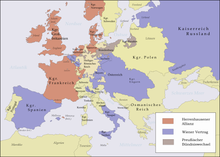
The War of the Polish Succession was a major European conflict sparked by a Polish civil war over the succession to Augustus II of Poland, which the other European powers widened in pursuit of their own national interests. France and Spain, the two Bourbon powers, attempted to test the power of the Austrian Habsburgs in Western Europe, as did the Kingdom of Prussia, whilst Saxony and Russia mobilized to support the eventual victor. The fighting in Poland resulted in the accession of Augustus III, who in addition to Russia and Saxony, was politically supported by the Habsburgs.
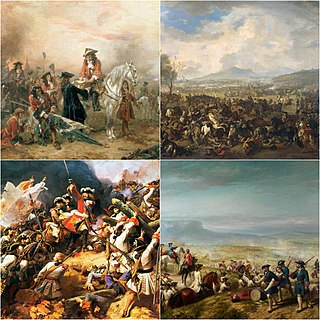
The War of the Spanish Succession was a European great power conflict that took place from 1701 to 1715. Charles II of Spain died in November 1700 without children, leading to a struggle for control of the Spanish Empire. The nominated heir, French-born Philip of Anjou, was primarily backed by Spain and France, while his rival, Archduke Charles, was supported by the Grand Alliance, whose chief members included Austria, the Dutch Republic, and Great Britain. Related conflicts include the 1700 to 1721 Great Northern War, Rákóczi's War of Independence, the Camisards revolt in southern France, Queen Anne's War in North America, and minor trade wars in India and South America.
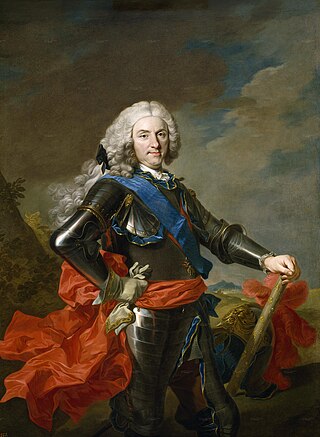
Philip V was King of Spain from 1 November 1700 to 14 January 1724 and again from 6 September 1724 to his death in 1746. His total reign is the longest in the history of the Spanish monarchy, surpassing Philip II. Philip V instigated many important reforms in Spain, most especially the centralization of power of the monarchy and the suppression of regional privileges, via the Nueva Planta decrees, and restructuring of the administration of the Spanish Empire on the Iberian peninsula and its overseas regions.

Charles III was King of Spain in the years 1759 to 1788. He also was Duke of Parma and Piacenza, as Charles I (1731–1735); King of Naples, as Charles VII; and King of Sicily, as Charles V (1734–1759). He was the fourth son of Philip V of Spain and the eldest son of Philip's second wife, Elisabeth Farnese. He was a proponent of enlightened absolutism and regalism.

Charles VI was Holy Roman Emperor and ruler of the Austrian Habsburg monarchy from 1711 until his death, succeeding his elder brother, Joseph I. He unsuccessfully claimed the throne of Spain following the death of his relative, Charles II. In 1708, he married Elisabeth Christine of Brunswick-Wolfenbüttel, by whom he had his four children: Leopold Johann, Maria Theresa, Maria Anna, and Maria Amalia.
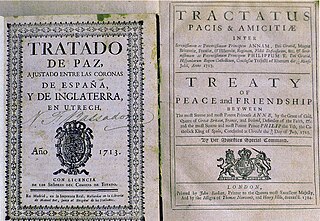
The Peace of Utrecht was a series of peace treaties signed by the belligerents in the War of the Spanish Succession, in the Dutch city of Utrecht between April 1713 and February 1715. The war involved three contenders for the vacant throne of Spain, and involved much of Europe for over a decade. The main action saw France as the defender of Spain against a multinational coalition. The war was very expensive and bloody and finally stalemated. Essentially, the treaties allowed Philip V to keep the Spanish throne in return for permanently renouncing his claim to the French throne, along with other necessary guarantees that would ensure that France and Spain should not merge, thus preserving the balance of power in Europe.
The Triple Alliance was a defence pact signed on 4 January 1717 in The Hague between the Dutch Republic, France and Great Britain, against Bourbon Spain in an attempt to maintain the agreements of the 1713–15 Peace of Utrecht. The three states were concerned about Spain becoming a superpower in Europe. As a result, militarisation took place and caused great havoc to civilians. That enraged Spain and other states and led to brinkmanship. The alliance became the Quadruple Alliance the next year, after the accession of Holy Roman Emperor Charles VI.

The War of the Quadruple Alliance was fought from 1718 to 1720 by Spain, and the Quadruple Alliance, a coalition between Britain, France, Austria, and the Dutch Republic. Caused by Spanish attempts to recover territories in Italy ceded in the 1713 Peace of Utrecht, most of the fighting took place in Sicily and Spain, with minor engagements in North America and Northern Europe. Spain also supported the Jacobite rising of 1719 in Scotland in an effort to divert British naval resources.
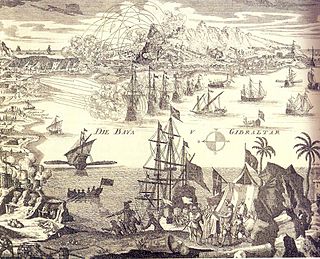
The Treaty of Seville was signed on 9 November 1729 between Britain, France, and Spain, formally ending the 1727–1729 Anglo-Spanish War; the Dutch Republic joined the Treaty on 29 November.

The Pacte de Famille is one of three separate, but similar alliances between the Bourbon kings of France and Spain. As part of the settlement of the War of the Spanish Succession that brought the House of Bourbon of France to the throne of Spain, Spain and France made a series of agreements that did not unite the two thrones, but did lead to cooperation on a defined basis.

The Battle of Bitonto was a Spanish victory over Austrian forces near Bitonto in the Kingdom of Naples in the War of Polish Succession. The battle ended organized Austrian resistance outside a small number of fortresses in the kingdom.

The Treaty of Hanover was a treaty of defensive alliance signed on 3 September 1725 by the Kingdom of Great Britain, the Electorate of Hanover, the Kingdom of France and the Kingdom of Prussia. The alliance was formed to combat the power of the Austro-Spanish alliance, which was founded at the Peace of Vienna months earlier in May 1725.
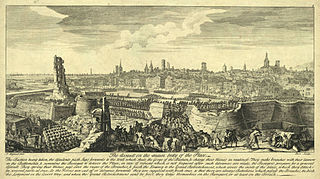
The siege of Barcelona was a thirteen month battle at the end of the War of Spanish Succession, which pitted Archduke Charles of Austria against Philip V of Spain, backed by France in a contest for the Spanish crown.

The 1731 Treaty of Vienna was signed on 16 March 1731 between Great Britain and Emperor Charles VI on behalf of the Habsburg monarchy, with the Dutch Republic included as a party.

The 1720 Treaty of The Hague was signed on 17 February 1720 between Spain and the Quadruple Alliance, established by the 1718 Treaty of London. Its members included Britain, France, the Dutch Republic and Austria.

The descendants of Philip V of Spain, Bourbon monarch of the Kingdom of Spain, Kingdom of Naples, and Kingdom of Sicily are numerous. He had two wives; by his first wife Maria Luisa of Savoy he had two children. After the death of his first wife, Philip married Elisabeth of Parma and they had children. Philip's descendants have formed a major part of history around the globe; several becoming monarchs of Spain, Portugal and Sardinia.

The Kingdom of Sicily was ruled by the House of Savoy from 1713 until 1720, although they lost control of it in 1718 and did not relinquish their title to it until 1723. The only king of Sicily from the House of Savoy was Victor Amadeus II. Throughout this period Sicily remained a distinct realm in personal union with the other Savoyard states, but ultimately it secured for the House of Savoy a royal title and a future of expansion in Italy rather than in France. During this period, the Savoyard monarch used his new title to affirm his sovereign independence.
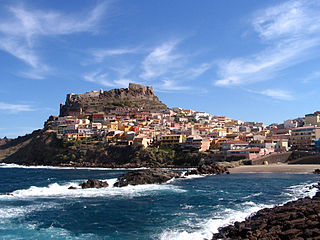
The Spanish conquest of Sardinia, also known as the Spanish expedition to Sardinia, took place between 22 August 1717 and 30 October 1717. It was the first military action between the Kingdom of Spain and the Holy Roman Empire after the War of the Spanish Succession (1701–1714), and was the direct cause of the War of the Quadruple Alliance (1718–1720). The Spanish troops commanded by the Marquis of Lede and Don José Carrillo de Albornoz, 1st Duke of Montemar, supported by the Spanish fleet, defeated the Emperor's troops easily, and conquered the entire island of Sardinia, which had been ruled by the Emperor since the Treaty of Rastatt (1714), returning it again and for the final time to Spain.

From 1700 to 1720, the Kingdom of Sardinia, as a part of the Spanish empire, was disputed between two dynasties, the Habsburgs and the Bourbons. With the death of Charles II, the last of the Spanish Habsburgs, on 1 November 1700, the throne passed to Duke Philip of Anjou, although the Emperor Leopold I also had a claim. Leopold was especially desirous of obtaining the Spanish inheritance in the Southern Netherlands and in Italy, which included Sardinia. With the failure of France to abide by the Second Partition Treaty, the other European powers lined up on the side of the Habsburgs. The Treaty of the Hague allotted to the Emperor the Spanish possessions in Italy. Imperial troops invaded Italy to seize them, and the War of the Spanish Succession began.

The Kingdom of Spain entered a new era with the death of Charles II, the last Spanish Habsburg monarch, who died childless in 1700. The War of the Spanish Succession was fought between proponents of a Bourbon prince, Philip of Anjou, and the Austrian Hapsburg claimant, Archduke Charles. After the wars were ended with the Peace of Utrecht, Philip V's rule began in 1715, although he had to renounce his place in the succession of the French throne.



